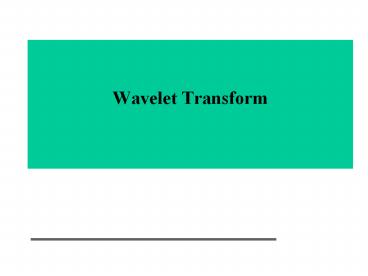Wavelet Transform PowerPoint PPT Presentation
1 / 21
Title: Wavelet Transform
1
Wavelet Transform
2
What Are Wavelets?
- In general, a family of representations using
- hierarchical (nested) basis functions
- finite (compact) support
- basis functions often orthogonal
- fast transforms, often linear-time
3
MULTIRESOLUTION ANALYSIS (MRA)
- Wavelet Transform
- An alternative approach to the short time Fourier
transform to overcome the resolution problem - Similar to STFT signal is multiplied with a
function - Multiresolution Analysis
- Analyze the signal at different frequencies with
different resolutions - Good time resolution and poor frequency
resolution at high frequencies - Good frequency resolution and poor time
resolution at low frequencies - More suitable for short duration of higher
frequency and longer duration of lower frequency
components
4
PRINCIPLES OF WAVELET TRANSFORM
- Split Up the Signal into a Bunch of Signals
- Representing the Same Signal, but all
Corresponding to Different Frequency Bands - Only Providing What Frequency Bands Exists at
What Time Intervals
5
Wavelet Transform (WT)
- Wavelet transform decomposes a signal into a set
of basis functions. - These basis functions are called wavelets
- Wavelets are obtained from a single prototype
wavelet y(t) called mother wavelet by dilations
and shifting - (1)
- where a is the scaling parameter and b is the
shifting parameter
6
- The continuous wavelet transform (CWT) of a
function f is defined as - If y is such that
- f can be reconstructed by an inverse wavelet
transform
7
SCALE
- Scale
- agt1 dilate the signal
- alt1 compress the signal
- Low Frequency -gt High Scale -gt Non-detailed
Global View of Signal -gt Span Entire Signal - High Frequency -gt Low Scale -gt Detailed View
Last in Short Time - Only Limited Interval of Scales is Necessary
8
Wavelet transform vs. Fourier Transform
- The standard Fourier Transform (FT) decomposes
the signal into individual frequency components. - The Fourier basis functions are infinite in
extent. - FT can never tell when or where a frequency
occurs. - Any abrupt changes in time in the input signal
f(t) are spread out over the whole frequency axis
in the transform output F(?) and vice versa. - WT uses short window at high frequencies and long
window at low frequencies (recall a and b in
(1)). It can localize abrupt changes in both
time and frequency domains.
9
RESOLUTION OF TIME FREQUENCY
10
Discrete Wavelet Transform
- Discrete wavelets
- In reality, we often choose
- In the discrete case, the wavelets can be
generated from dilation equations, for example, - f(t) h(0)f(2t) h(1)f(2t-1)
h(2)f(2t-2) h(3)f(2t-3). (2) - Solving equation (2), one may get the so called
scaling function f(t). - Use different sets of parameters h(i)one may get
different scaling functions.
11
Discrete WT Continued
- The corresponding wavelet can be generated by the
following equation - y (t) h(3)f(2t) - h(2)f(2t-1)
h(1)f(2t-2) - h(0)f(2t-3). (3) - When and
- equation (3)
generates the D4 (Daubechies) wavelets.
12
Discrete WT continued
- In general, consider h(n) as a low pass filter
and g(n) as a high-pass filter where - g is called the mirror filter of h. g and h are
called quadrature mirror filters (QMF). - Redefine
- Scaling function
13
Discrete Formula
- Wavelet function
- Decomposition and reconstruction of a signal by
the QMF. - where and is down-sampling and is
up-sampling
14
Generalized Definition
- Let be matrices, where are
positive integers - is the low-pass filter and is the
high-pass filter. - If there are matrices and
which satisfy - where is an identity matrix. Gi
and Hi are called a discrete wavelet pair. - If and
- The wavelet pair is said to be
orthonormal.
15
- For signal let and
- One may have
- The above is called the generalized Discrete
Wavelet Transform (DWT) up to the scale - is called the smooth part of the DWT and
- is called the DWT at scale
- In terms of equation
16
Multilevel Decomposition
- A block diagram
2
2
17
Haar Wavelets
Example Haar Wavelet
18
Summary on Haar Transform
- Two major sub-operations
- Scaling captures info. at different frequencies
- Translation captures info. at different locations
- Can be represented by filtering and downsampling
- Relatively poor energy compaction
19
2D Wavelet Transform
- We perform the 2-D wavelet transform by applying
1-D wavelet transform first on rows and then on
columns. - Rows Columns
- LL
- f(m, n) LH
- HL
- HH
2
H
2
H
2
G
2
H
G
2
2
G
20
Applications
- Signal processing
- Target identification.
- Seismic and geophysical signal processing.
- Medical and biomedical signal and image
processing. - Image compression (very good result for high
compression ratio). - Video compression (very good result for high
compression ratio). - Audio compression (a challenge for high-quality
audio). - Signal de-noising.
21
3-D Wavelet Transform for Video Compression
Original Video Sequence
Reconstructed Video Sequence

